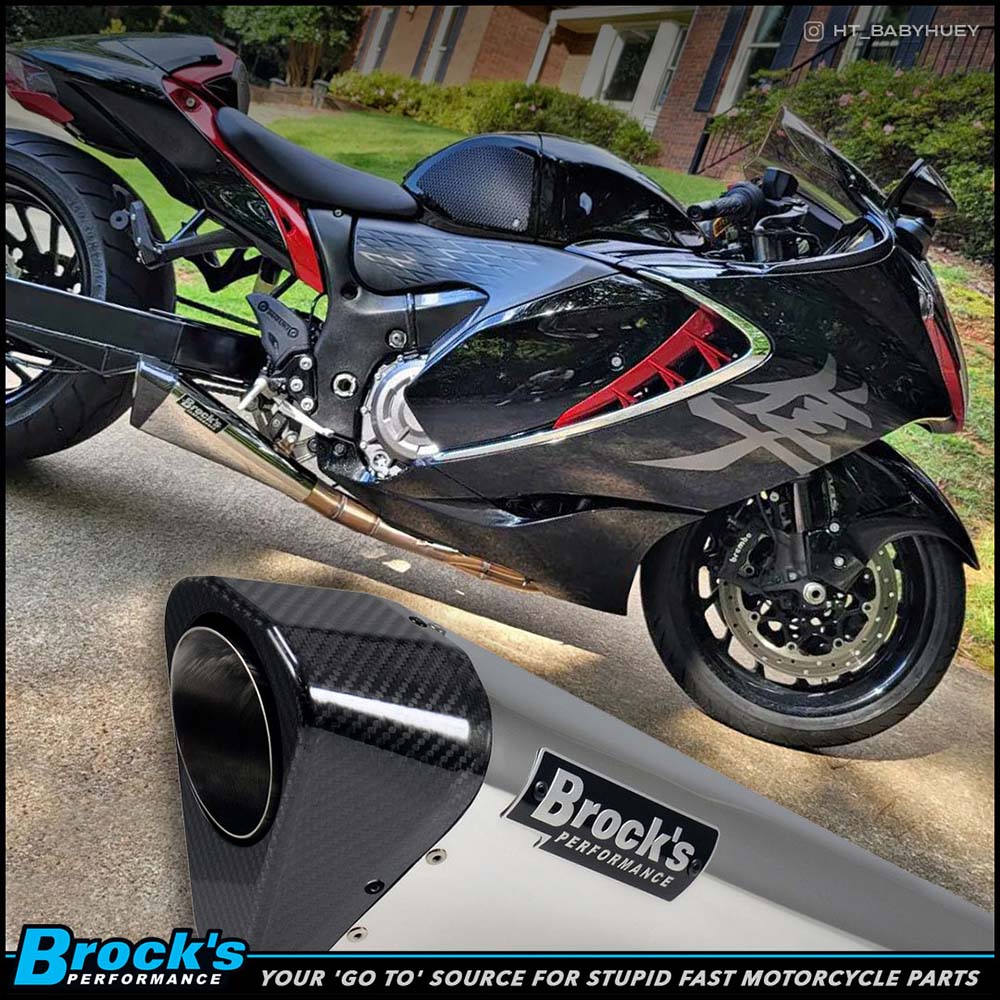Are you dealing with an overly hot exhaust system during the summer? Or, maybe you find that your exhaust is overheating on long trips. Not only is overheating uncomfortable for a rider, but it can also lead to engine or exhaust damage.
Luckily, there are some ways to cool down the riding experience. However, there are also some methods that may do more harm than good, such as exhaust covers. We'll go over the safe and effective ways to keep your exhaust system in a safe temperature range. We'll also discuss how to choose the best aftermarket exhaust system to keep your bike cool and your riding experience comfortable on those long trips and hot summer days.
How Does an Exhaust System Work?
The purpose of an exhaust system is to expel hot gasses produced by the engine. The exhaust system functions by moving gasses made in the combustion chamber through pipes to exit the motorcycle. By getting rid of the hot gasses, your engine can stay at an optimal temperature range.
With this process, the exhaust system plays a large role in different performance aspects of the bike. When you upgrade to a high-quality exhaust system, a bike will experience benefits such as an improvement in speed, handling, efficiency, and safety.

Common Materials Used for Exhaust Systems
There are several commonly used materials in motorcycle exhausts. Some of the most commonly used materials are steel or aluminum alloys. These kinds of materials are typically used in OEM exhausts due to their affordability. However, though they have a great price point, they typically aren't the best option available. If you stick with the stock exhaust for your motorcycle, you won't experience the performance and efficiency gains that aftermarket exhausts offer.
Aftermarket exhausts are generally designed to function more optimally than stock exhausts. However, they can be expensive due to their high-quality materials, which may not suit every rider's budget. Usually, aftermarket exhausts are made out of carbon fiber or titanium.
These materials are much more lightweight than steel or aluminum options. Thanks to their lightweight, these types of exhausts offer many advantages over stock exhausts. Some of the advantages include temperature resistance, improved efficiency, power gains, and better acceleration.
With high-quality aftermarket exhaust upgrades, like carbon fiber options, you'll be able to avoid the risks associated with an overheated exhaust system. This type of material is better able to resist the high temperatures of the exhaust system, allowing for a cooler riding experience.
What Is the Optimal Temperature Range for Exhaust Systems?
Exhaust systems are designed to function at hot temperatures–think 600 to 1,000 degrees Fahrenheit. However, sometimes exhausts can get too hot, which may lead to the engine overheating. When that happens, there are many potential risks that could lead to serious problems.
What Happens If Your Exhaust System Doesn't Cool Down During Your Ride?
Exhausts are designed to handle high temperatures. However, when your exhaust system gets overheated, it may lead to issues with performance and comfort or damage to the engine, exhaust, or other parts of the motorcycle. The excessive heat may also pose safety concerns, as an overheated exhaust could lead to a chance of fire.
Some riders may be sensitive to the excessive heat of their exhaust. No rider wants to feel uncomfortable while trying to perform their best at the track or have to deal with unpleasant sensations while taking a ride on the highway. This discomfort not only leads to a loss of enjoyment but may be a safety risk. Riders should remain alert and as comfortable as possible to ensure that their attention remains focused on the road. Dealing with pesky issues, like uncomfortable heat, could be a safety concern, especially on long trips or during hot weather.
Besides being uncomfortable, you may have to deal with an overheated engine. When your bike's engine gets too hot, it could lead to damage, smoking, fire, and other safety hazards. This can lead to costly repairs and replacements to your engine. If you feel like your engine may be overheating, check the temperature gauge on your dashboard or your bike may have a heat warning sign that lights up. If you suspect that your engine is overheating, it's important to let it cool down. You should shut off the engine and leave it be for at least a half hour. However, you should be sure to never splash cold water on the bike, as this could lead to damage.

How Can You Cool Down the Riding Experience?
There are a few different strategies for cooling down the riding experience, ensuring that you remain safe and comfortable. Plus, with these strategies, your bike will be free from the potential risks of heat damage. If you suspect that your bike is overheating or you want to prevent it from happening, there are a few precautions and solutions to consider.
Adjust the Fuel/Air Ratio
If you notice that your bike is overheating, you should consider the fuel/air ratio. When your engine runs too lean (not enough fuel), it often leads to an overheated muffler. You'll also notice other performance issues, like poor efficiency, backfires, and a sluggish engine. If you suspect a poor fuel/air ratio, you should take it to a mechanic for a check-up. They'll be able to properly diagnose and adjust your bike to get the ratio back to normal.
Check Your Oil
Another reason your bike may be experiencing overheating is low oil levels. Regular and proper maintenance is a good way to ensure your bike stays cool. You should always follow your bike manufacturer's instructions on a proper maintenance schedule to ensure you change the oil on time. It's important to remember to follow the proper maintenance schedule and use the correct type of oil for your bike.
Over time, if you forget to change or top off your oil, your engine is likely to overheat. Additionally, not maintaining your oil will also lead to other internal problems within your engine. With all of these issues, you'll want to make sure that you follow the manufacturer's instructions and perform the task carefully.
Check Your Coolant Levels
If you find that your bike is overheating, the issue may be low coolant levels. In your manufacturer's instruction manual, it should give timeframes for replacing your coolant. However, you should regularly check your coolant to ensure that it's at the proper level. If you see that the coolant level is below where it should be, top off the fluids so it's at the maximum level.
Avoid Idling
Leaving your bike idle for a long time can lead to overheating. It's not good practice to have your motorcycle idling for long periods, as it will mess with the exhaust. A good way to avoid this issue is to avoid heavy traffic as much as possible. You should also warm up your engine and leave it running for about a minute before you start riding. Any more time than that is not good for your bike. Additionally, you should turn off your engine whenever you're not using it to avoid unnecessary wear on your engine.
Examine the Exhaust Pipe
Sometimes, an exhaust pipe will crack or retain a hole in the metal. This can happen for a number of reasons, but if you suspect you have an exhaust leak, you should get it checked out. If your bike has an exhaust leak, it could lead to the engine overheating, as the gasses are not able to pass through the exhaust system properly.
There are many signs that indicate an exhaust leak, such as backfiring, tinking noises, loose exhaust bolts, and loud idling. You should also be concerned if your engine is overheating. When you notice these symptoms, you should examine the bike yourself or take it to a mechanic.
Upgrade Your Exhaust System
If you want to prevent overheating, the best solution is to invest in high-quality parts. Aftermarket exhausts are typically better at handling the high temperature of the gases exiting the exhaust system. Typically, OEM exhausts are not made out of the highest quality materials. Manufacturers choose metals that are the most cost-efficient options for the stock exhausts. That's why many motorcyclists consider aftermarket exhausts instead. Upgrading to an exhaust system with materials that are better able to handle the heat will help to ensure that your riding experience stays cool.
Carbon fiber exhausts are particularly great at keeping your bike cool. Even on hot days when temperatures are high, an upgraded exhaust system can keep your bike in an optimal temperature range. Titanium is another high-quality material that offers heat protection. If you're looking for the best exhaust system upgrades, you should consider both of these options for your bike.

Should You Use an Exhaust Cover?
You may have heard of exhaust covers as a solution to keep your bike from overheating. However, it's generally not a good idea to use an exhaust cover for your bike. Though they can reduce heat and keep temperatures in the right range, exhaust covers could eventually lead to damage to your exhaust system. It's best to find other solutions to overheating problems or invest in higher-quality aftermarket exhausts that are heat resistant.
Choosing the Best Exhaust Systems for Your Bike
Choosing the best exhaust system for your bike depends on a lot of different factors. For example, you'll need to consider your budget. Aftermarket exhausts tend to be pricey. However, due to their many performance advantages and heat-resistant properties, upgraded exhausts are well worth the investment. Some aftermarket exhaust systems may even be up to 30% cooler during a ride than stock exhausts.
When choosing between different types of aftermarket exhausts, you should consider titanium and carbon fiber options. Both of these materials are better at handling high temperatures than stock exhausts. If you're interested in purchasing a Titanium full exhaust system, then you should consider these options. The exhaust systems are a bit pricey, but they are perfect for racers who need an ultra-lightweight option that can handle high temperatures.
You may also want to consider these carbon fiber aftermarket exhausts. These exhausts offer a lot of great advantages over stock options. If you're looking for an exhaust system that will keep cool during rides, carbon fiber exhausts are a great choice. They also offer some of the same performance benefits as Titanium exhausts due to their lightweight.
Upgrading a motorcycle's stock exhaust to an aftermarket system is a popular and common choice. Why are exhausts a popular modification? High-quality aftermarket exhausts offer a lot of benefits, including performance and efficiency gains. In addition to these advantages, aftermarket exhausts are typically made out of higher-quality materials than the stock option, which can impact temperature resistance. Titanium and carbon fiber exhausts stay cooler than other types of materials.
If you want to avoid overheating your engine and keep your ride cool, you'll want to take all of the necessary precautions. Keeping your fluids topped off, avoiding idling, and upgrading your exhaust system are all great ways to cool down your riding experience, so you stay comfortable and your bike is kept in good condition. If you're ready to start shopping for high-quality aftermarket exhausts for your bike, check out our full selection of exhausts.
